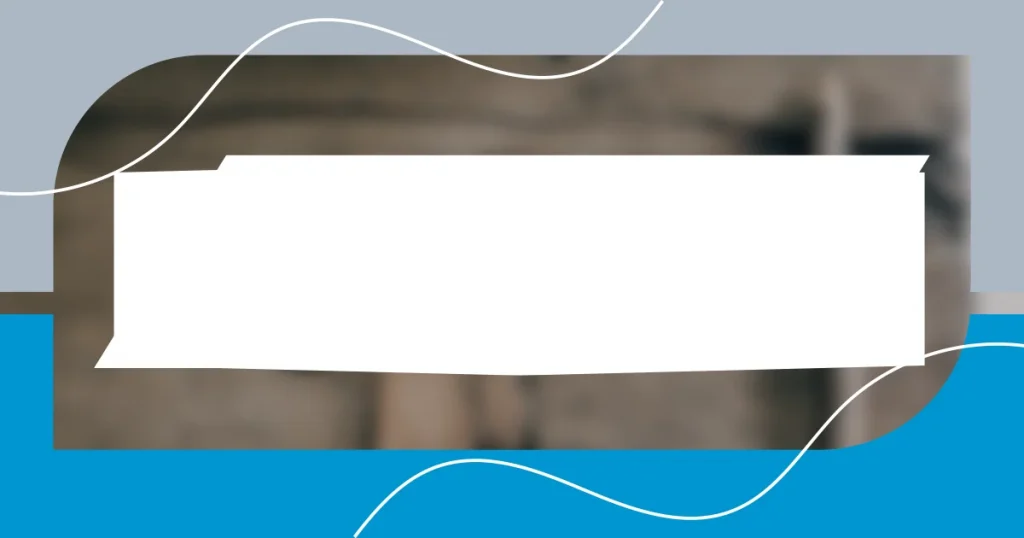Key takeaways:
- Polyurethane enhances durability and aesthetics in projects, effectively protecting surfaces from stains and scratches.
- Preparing surfaces through proper sanding, dust removal, and using suitable cleaners is crucial for achieving a flawless finish.
- Regular maintenance, including gentle cleaning and periodic inspections, helps preserve the beauty and longevity of polyurethane finishes.

Understanding polyurethane benefits
One of the standout benefits of polyurethane that I’ve personally experienced is its durability. In a recent DIY project, I used polyurethane to finish my wooden dining table, and the difference was astounding. Not only did it enhance the wood’s grain, but it also protected against stains and scratches, which is a lifesaver when you have kids at home. Have you ever felt the frustration of a mark on your furniture that just won’t come off? With polyurethane, those worries fade away.
What truly amazes me about this material is its versatility. Whether you’re working on floors, furniture, or crafts, polyurethane can adapt to your needs. I remember using a water-based version for some indoor decor; the ease of application and quick drying time made the whole experience enjoyable rather than a chore. How great is it to get such professional-looking results without the headache of lengthy processes?
I’ve also come to appreciate the aesthetic benefits of polyurethane. One time, I opted for a glossy finish on a set of shelves I crafted, and the visual impact was incredible. The shimmer not only elevated the look but also made my space feel warmer and more inviting. It got me thinking: how can such a clear finish create such a rich depth? That’s the magic of polyurethane, making your projects shine both literally and figuratively.

Choosing the right polyurethane type
When it comes to selecting the right type of polyurethane, the first consideration should be the environment where you plan to use it. I can’t stress enough the difference between water-based and oil-based polyurethane. After I tried using oil-based on my outdoor furniture, the durability impressed me. However, the strong fumes were a challenge to work with. If you’re looking for something low-odor, especially for indoor projects, water-based might be the way to go.
Here are key factors to consider when choosing the right polyurethane type:
- Application Area: Indoor vs. outdoor – some formulas work better in varying environments.
- Finish Desired: Glossy, semi-gloss, or matte – each offers a different aesthetic.
- Drying Time: Water-based dries quickly, while oil-based can take longer, impacting project timelines.
- Durability Requirements: Think about wear and tear; more durable options may require a more careful application process.
- Odor Sensitivity: Consider whether you’re sensitive to smells; some versions are more manageable than others.
In my experience, mixing these elements helped me achieve the best outcome for each project. It felt rewarding to know I was making informed decisions based on what works best for me. The right type not only enhanced the visual appeal of my projects but also brought a sense of satisfaction knowing I chose wisely for the longevity of the finish.

Preparing surfaces for applying polyurethane
Preparing surfaces for applying polyurethane is crucial for achieving a flawless finish. I remember one project where I was so eager to get started that I skipped the prep phase, and let me tell you, it didn’t go well. The surface felt rough, and imperfections stood out like sore thumbs once the polyurethane was applied. In hindsight, I realized that taking the time to sand the surface properly and clean it thoroughly made all the difference. Have you ever seen a finish that lacks the smooth touch? It’s such a letdown when simple preparation could have prevented that.
When I sanded my wooden dresser before applying the finish, I noticed that using finer grit sandpaper led to a remarkable transformation. The process was almost therapeutic; each stroke revealed the wood’s character, making it ready to accept the polyurethane like a sponge. I generally start with something like 120-grit and finish with 220-grit. It’s a small step that yields such impactful results. Also, don’t forget to dust off the surface afterward. That’s something I used to overlook, but I learned that a clean surface prevents unsightly particles from mingling with the shiny new finish.
I can’t stress enough the importance of choosing the right cleaner before applying polyurethane. I initially used a common household cleaner to prep a coffee table, but I quickly learned that it left residues that interfered with the finish. Now, I prefer using mineral spirits or a simple mixture of vinegar and water. My experiences make it clear: the cleaner the surface, the better your final outcome will be. Trust me, there’s a certain joy in seeing your hard work pay off when you have that perfect shine.
| Preparation Step | Importance |
|---|---|
| Sanding | Creates a smooth surface for better adhesion and finish quality. |
| Dust Removal | Eliminates particles that could mar the finish. |
| Cleansing | Prepares the surface by removing oils and residues that can affect adhesion. |

Applying polyurethane correctly
Applying polyurethane correctly involves a careful and deliberate approach. I learned the hard way that applying too thick a coat can lead to a tacky finish. When I once rushed through a project, I ended up with unsightly drips that haunted me every time I glanced at the piece. I suggest starting with thin, even layers and allowing proper drying time between each to avoid those mishaps.
When I apply polyurethane, I always use a quality brush or foam applicator. I remember the first time I used a cheap brush—it left bristles in the finish, which truly tested my patience. Have you ever felt that frustration when your hard work is marred by something so fixable? Switching to a higher-quality brush not only improved the finish but also made the application process feel more rewarding. It’s those little choices that transform a good outcome into a great one.
I also pay close attention to the environmental conditions when applying polyurethane. I once attempted a project on a humid day, and the finish took ages to dry, leaving a sticky residue that was a nightmare. I soon realized that temperatures between 70°F and 80°F with low humidity create the best conditions. In my experience, it’s always worth checking the weather and planning your projects accordingly—it saves you from headaches and enhances the final result. When everything aligns, the satisfaction of seeing a pristine finish is irreplaceable.

Maintaining polyurethane finishes over time
Maintaining a polyurethane finish over time requires a bit of commitment, but the results are worth it. I’ve often found myself admiring the surfaces in my home, knowing that a little upkeep goes a long way in preserving their beauty. For instance, I make it a habit to gently dust my furniture every week, which not only keeps things looking sharp but also minimizes the chances of dirt and grime scratching the surface. Have you ever seen a beautiful table lose its luster due to neglect? It’s such a shame when a little attention could have easily prevented it!
Every few months, I conduct a thorough inspection of my finished pieces. Just the other day, I discovered that a small area on my dining table—a spot that often sees heavy use—was starting to show signs of wear. Instead of panicking, I lightly sanded that section and reapplied a thin coat of polyurethane. This simple act of maintenance not only restored the shine but also gave me the satisfaction of knowing I could extend the life of my project. How often do you take a moment to check your finishes? It’s surprising how an occasional refresh can make them look brand new again.
Another vital aspect of upkeep is avoiding harsh chemicals when cleaning. Trust me, I learned this the hard way after using an abrasive cleaner on a cherished piece, which dulled the finish significantly. Now, I stick to mild soap and water, treating my finishes as delicately as they deserve. It brings joy to see them sparkling without any damage. The lesson here? Always read the labels—your finishes will thank you, and you’ll preserve all that hard work you’ve put in.













